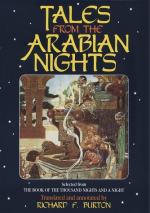following: No. 15 of M. Leger’s French collection
of Slav Tales is a Bohemian version, in which the
hero, Jenik, saves a dog, a cat, and a serpent from
being killed. From the serpent’s father
he gets an enchanted watch (evidently a modern substitute
for a talismanic stone, or ring), which procures him
a splendid palace and the King’s daughter for
his bride. But the young lady, unlike the Princess
Badr al-Badur with Aladdin, does not love Jenik, and
having learned from him the secret of his great wealth,
she steals the talisman and causes a palace to be
built in the middle of the sea, where she goes to
live, after making Jenik’s palace disappear.
Jenik’s faithful dog and cat recover the talisman,
which, as in the Arabian story of the Fisherman’s
Son, is dropped in the sea while they are swimming
back and restored by a fish.—In No. 9 of
M. and so “Comes Albanais” the hero saves
a serpent’s life and gets in return a wishing-stone
and so on. The talisman is stolen by a rascally
Jew on the night of the wedding, and the palace with
the princess is transported to the distant sea-shore.
The hero buys a cat and feeds it well. He and
his cat arrive at the spot where the palace now stands,
and the cat compels the chief of a colony of mice to
steal the talisman from the Jew while he is asleep.—A
popular Greek version in Hahn’s collection combines
incidents found in Aladdin and in the versions in which
grateful animals play prominent parts: The hero
rescues a snake which some boys are about to kill
and gets in reward from the snake’s father a
seal-ring, which he has only to lick and a black man
will present himself, ready to obey his orders.
As in Aladdin, the first use he makes of the talisman
is to have his mother’s cupboard filled with
dainty food. Then he bids his mother “go
to the King, and tell him he must give me his daughter
in marriage.” After many objections, she
goes to deliver her message to the King, who replies
that if her son build a castle larger than his, he
shall have the princess to wife. The castle is
built that same night, and when the mother goes next
morning to require the King’s performance of
his promise, he makes a further stipulation that her
son should first pave the way between the two castles
with gold. This is done at once, and the King
gives the hero his daughter. Here the resemblance
to the Aladdin story ceases and what follows (as well
as what precedes) is analogous to the other Asiatic
forms. The princess has a black servant of whom
she is enamoured. She steals the ring and elopes
with her sable paramour to an island in the sea, where
she has a castle erected by the power of the ring.
The black man sleeps with the ring under his tongue,
but the hero’s dog takes the cat on his back
and swims to the island; and the cat contrives to
get the ring and deliver it to her master, who straightway
causes the castle to be removed from the island, then
kills the black man, and afterwards lives happily
with the princess.—In a Danish version (Prof.




